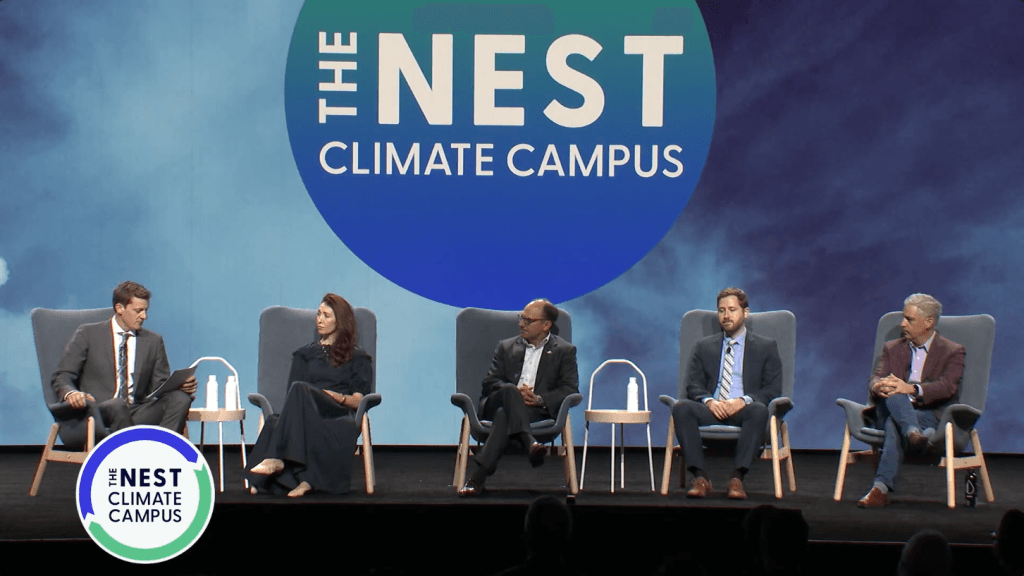AI-Ready Grids: Integrating Hyperscale Loads Faster, Cleaner, Cheaper at Nest Climate Campus, Climate Week 2025

This crucial panel, hosted at the Nest Climate Campus during Climate Week 2025, tackled one of the most pressing infrastructure challenges: how to sustainably power new AI data centers on the existing U.S. electrical grid. With energy use from large-scale cloud computing providers (hyperscalers) forecasted to consume anywhere from 6.7% to 12% of total U.S. load by 2030, experts discussed the policy, innovation, and investment needed to integrate these demands Faster, Cleaner, Cheaper.
The Panelists: Leaders in Energy Policy, Utilities, and AI Infrastructure
This dynamic panel brought together academics, utility executives, and industry leaders to discuss the transformation of the grid:
- Jackson Ewing, Director of Energy and Climate Policy, Nicholas Institute for Energy, Environment & Sustainability, Duke University (Moderator)
- Caroline Golin, Founder and CEO, Envision Energy Advisors (Former Global Head of Energy Market Development, Google)
- David Dardis, Executive Vice President and Chief Legal and Policy Officer, Constellation
- Jeff Bladen, Head of Energy, Verrus (Former Global Director of Energy, Meta)
- Tyler Norris, James B. Duke Fellow, Nicholas School of the Environment, Duke University
The Challenge: Shifting from Slow Service to Gigawatt-Scale Planning
The panel consensus was that both the industrial sector and utilities are facing an “equal inopportune moment” as load forecasts explode (with some projections showing 60-70 gigawatts of growth in regions like PJM and Texas in five years). The critical challenge addressed by Duke University was preparing the system for AI-Ready Grids Hyperscale Load integration.
The old model of getting one industrial customer and integrating them “just in time” is broken. Caroline Golin stressed the critical need for a “fundamental new approach to planning” that operates at the country level, not the municipality level, and involves gigawatts of capacity over long time horizons.
The discussion centered on three immediate solutions to manage this unprecedented demand:
1. Prioritizing Resilience and Existing Clean Assets
David Dardis of Constellation highlighted the immediate policy levers needed to manage the near-term challenge over the next five to seven years:
- Protect Existing Nuclear Fleet: He advocated for policy that protects and preserves the existing nuclear fleet, which provides over 20% of the power to PJM today, noting the importance of the nuclear production tax credit in the IRA.
- Solving Load Forecasting: Dardis pointed out the critical mismatch between the $350 billion global hyperscaler capital budget and regional projections like 60 GW in PJM in five years, underscoring the severity of the forecasting gap.
- Policy Parochialism: He called for policymakers to “look past our parochial interests” and view this challenge as critical to the country’s place in the world, urging states to avoid policies that threaten existing resources.
2. Unlocking Hidden Grid Capacity Through Flexibility
Tyler Norris presented research arguing that the focus must expand beyond just building new transmission to finding headroom in the existing system. The paper found that if new loads were willing to curtail their draw for just 0.25% of their maximum annual uptime (approximately 100-200 hours per year), it could unlock up to 76 gigawatts nationally (and 15 GW in PJM) of new grid capacity without added generation.
- Physical Manifestation: Jeff Bladen of Verrus explained that his company was founded to be the physical manifestation of this flexibility, making data centers far more efficient (targeting 90% load factor versus the traditional 65%) and using battery storage to shave off peak demand periods.
- Utility as an Asset: Bladen and David Dardis emphasized the need to reform the utility interconnection process to view customers not just as a load, but as an asset that can provide flexibility to the grid, especially through quasi-firm service tiers.
3. Smart Investment in Multi-Use Storage and Hybrid Loads
The panel agreed that a one-size-fits-all flexibility model won’t work, especially for hyperscalers where the opportunity cost of curtailing research outweighs any market signal currently available.
- External Flexibility: David Dardis shared that Constellation is aggressively working to contract flexible load from other customers (targeting 2 GW) to pair with less flexible data centers, using AI to manage the matching.
- Storage as a Swiss Army Knife: Caroline Golin and Jeff Bladen highlighted the potential of strategic storage placement to smooth out the erratic training loads of AI (storage inside the servers) and provide large-scale peak reduction for the grid. The key challenge is creating contract structures that value storage as a multi-use asset rather than just as marginal generation.
Session Conclusion: A Shift from Offsets to Investment
The discussion culminated in a call to action for the climate community, with Caroline Golin suggesting we stop asking: “But will they meet their climate goals?” and start asking: “What is the highest and best use of these $350 billion that are going to go into the grid annually?”
By viewing the massive capital being injected into infrastructure as an opportunity to shape the system, not just offset its impact, stakeholders can help streamline new capacity, avoid crowding out cleaner energy options, and secure a more resilient energy future.
Explore more transformative discussions from the Nest Climate Campus by checking out our full series of Climate Week 2025 sessions on ESG News:








